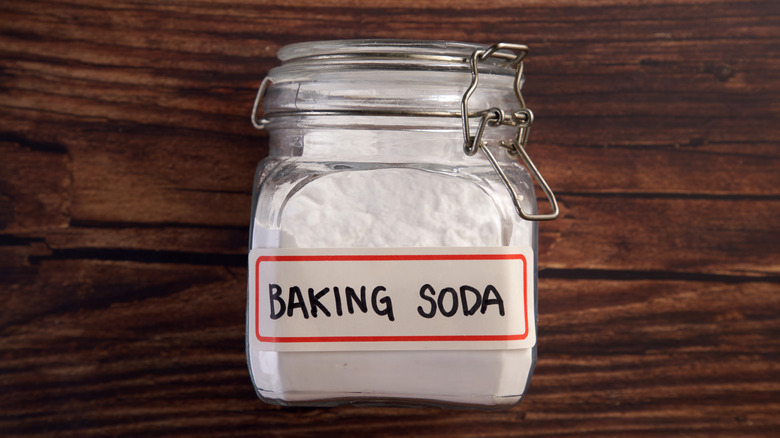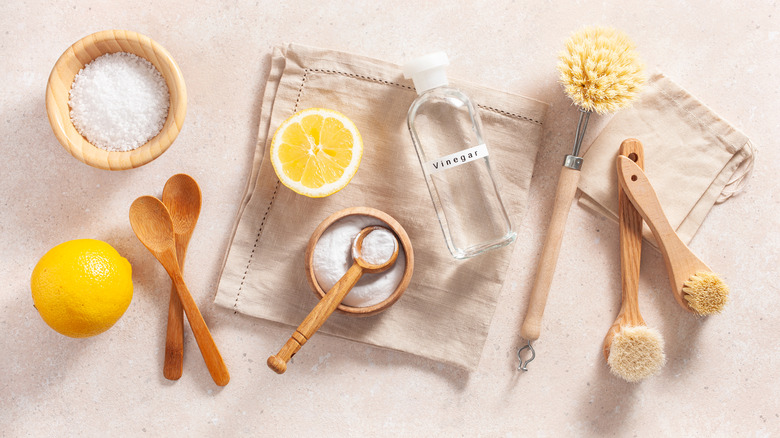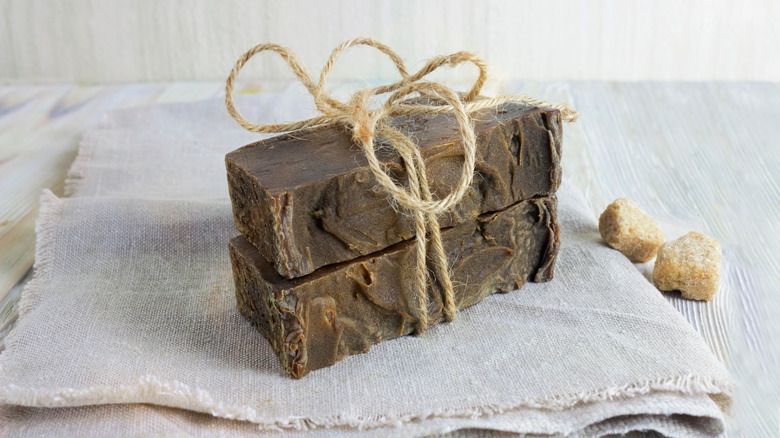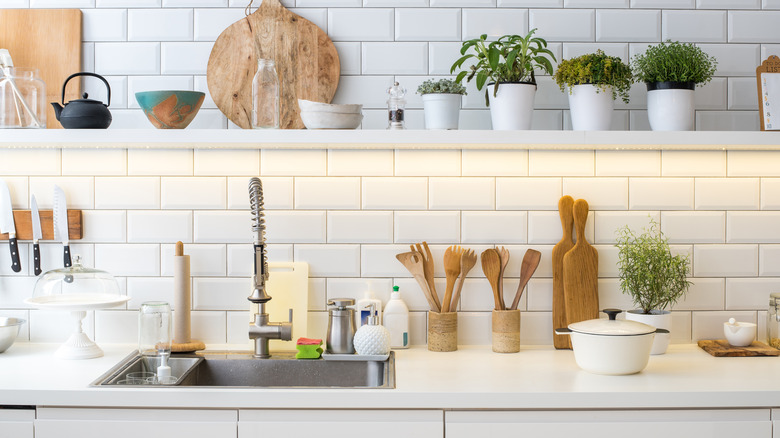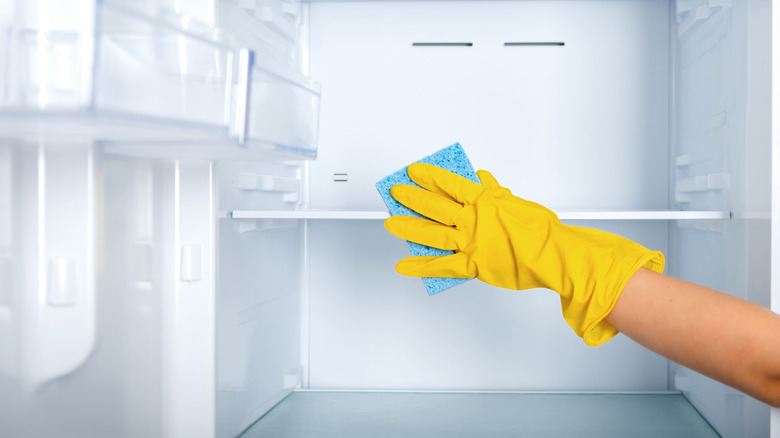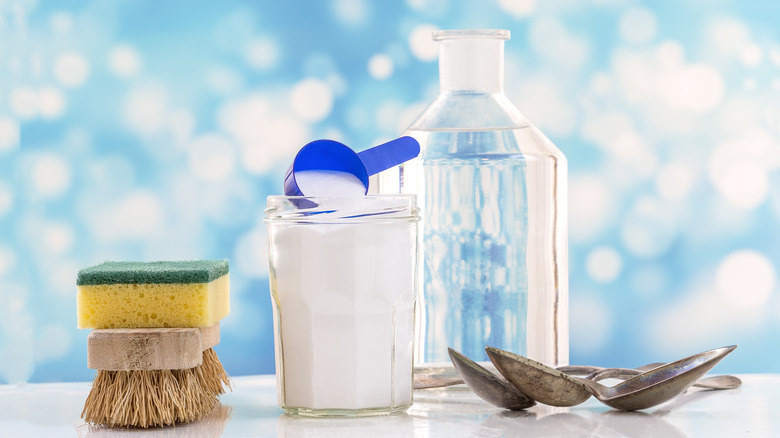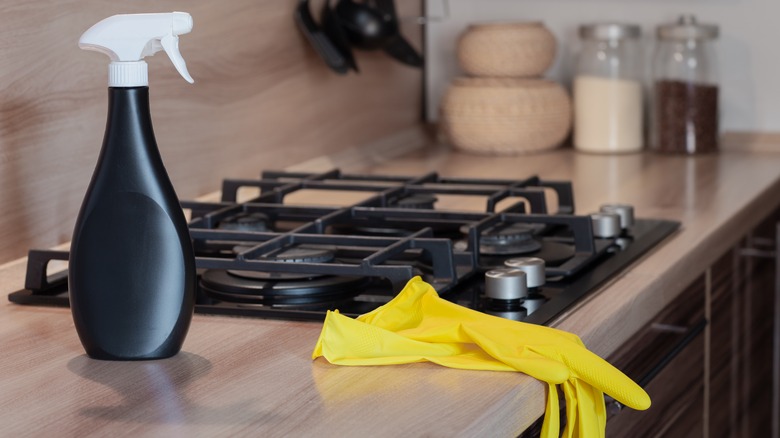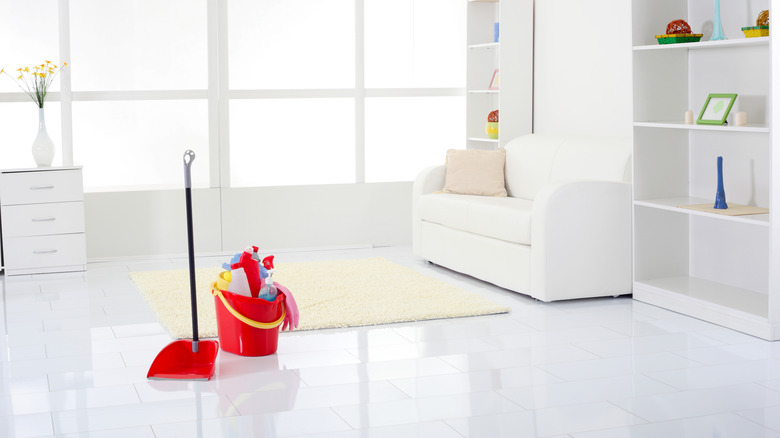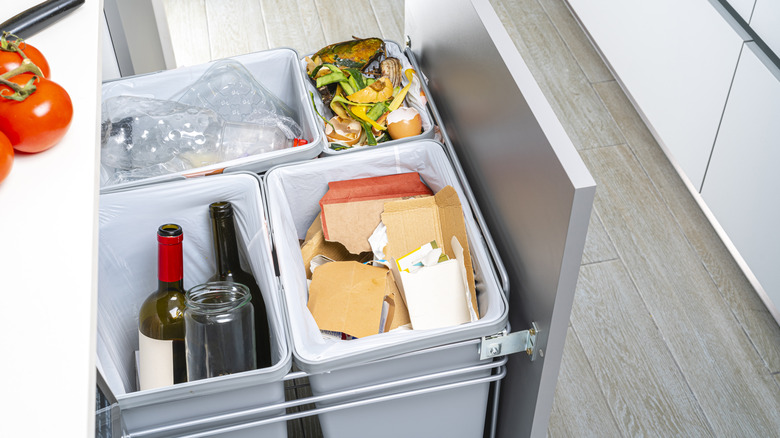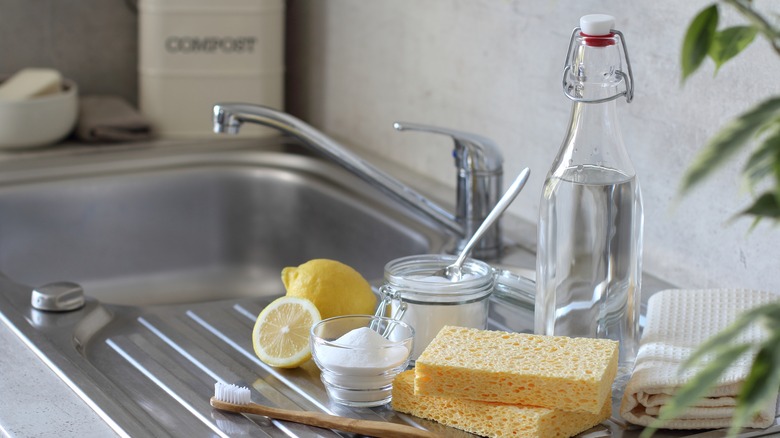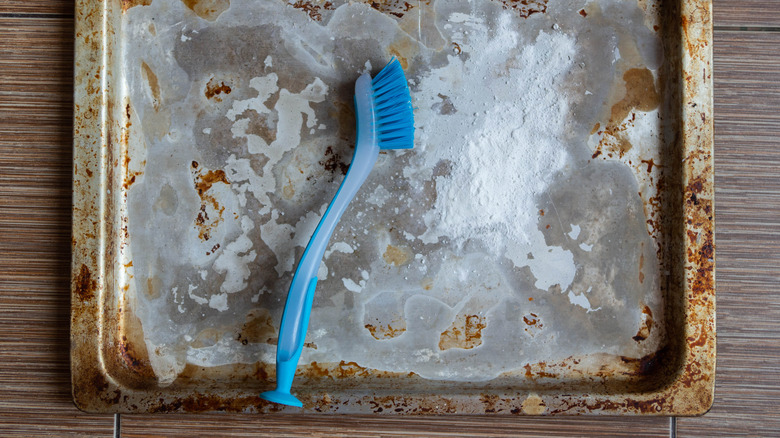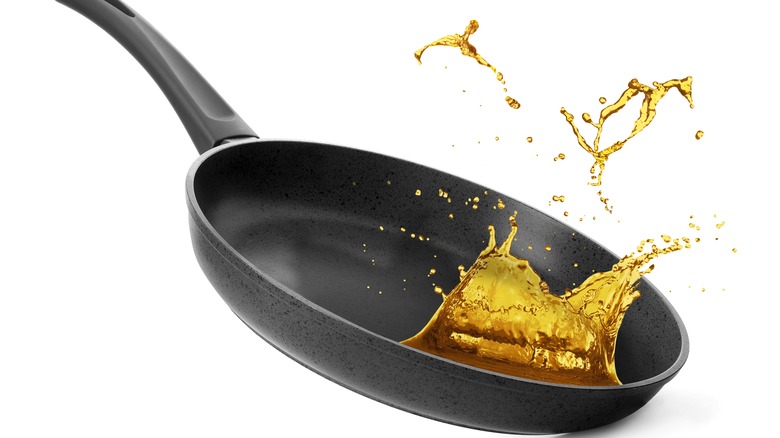The Best Way To Naturally Clean Your Kitchen With Baking Soda
A well-stocked kitchen includes a box of baking soda, but with a few additions, baking soda can be a powerful tool for more than baking. Baking soda can be a great natural, all-purpose kitchen cleaner.
Using baking soda, or to be more technical, sodium bicarbonate, to clean your kitchen is natural, and effective instead of harsh, abrasive chemicals. This also means no harsh chemical smells while you clean. Another advantage of using sodium bicarbonate as a cleanser is the cost. Grocery stores and home improvement stores sell 10.8-pound bags for about $12. You can't get much cheaper than that!
Why is baking soda such an amazing, inexpensive powerhouse? Baking soda is an alkaline, meaning that has the properties of an alkali. Alkali is a "soluble salt obtained from the ashes of plants and consisting largely of potassium or sodium carbonate," per Merriam-Webster. While knowing the chemical basis of baking soda may be more technical than most of us care about, understanding baking soda's basic makeup helps us understand why it's safe to use as an all-purpose cleaner.
Baking soda makes the ultimate, all-purpose cleaner
As a cleanser, baking soda can be a great base, but it needs a little help sometimes. With a few inexpensive additions, you can clean your entire kitchen, freshen your carpets, clean the bathroom, and even fix cloudy iced tea.
Using a white, distilled vinegar mixed with baking soda and a few drops of your favorite essential oil becomes an excellent, go-to degreaser. A ½ cup of vinegar, 2 tablespoons of baking soda, and a couple of drops of essential oil shaken together become a powerful, anti-microbial stain and odor eliminator for pennies.
Castile soap is another unsung hero when it comes to cleaning. Add approximately ⅓ cup castile soap with 2 tablespoons of baking soda and it becomes a toilet bowl cleaner. Increase the amounts of baking soda and add vinegar for a non-abrasive shower cleanser.
If you have wooden kitchen utensils, make a paste with a lemon and baking soda to remove odors. Soak in peroxide for 15 minutes, rinse well, then allow to air dry. This kills bacteria that can build up on wood utensils. To clean a cast iron skillet, sprinkle in baking soda with enough water to create a paste and scrub with a brush or pad. The baking soda will remove odors like fish and can kill bacteria.
Since you have the peroxide and baking soda out, mix them with liquid dish soap into a paste for an effective, non-caustic grout cleanser for backsplashes or other kitchen tile.
Bake your baking soda for a lye alternative
Lye has been used for centuries to make soap. Bakeries have used lye to create chewy exteriors for pretzels or bagels. But, what is lye, and why would you want an alternative if it is so useful? Lye historically was made by boiling down wood ashes mixed with animal fat and takes considerable amounts of time and effort to produce. While generations of housewives have been making lye soap, it's not the nicest soap when it's finished. If the soap is not correctly balanced between lye and lard, too much lye can burn the skin.
It makes you wonder why bakeries are using it to make food! Lye is caustic but was used because it was powerful to clean dishes or other household chores. Imagine what it does to your hands, though.
Since our hands have to do a lot of scrubbing and work in the kitchen, they can take a beating. You can make beautiful soap using baking soda, olive oil, and a few other beneficial oils to keep your hands soft. Instead of lye, baking soda can be a strong, but not harsh, option.
You can make your own baking soda soap using not much more than baking soda, water, and essential oils mixed together until it forms a paste. Continue stirring until the mixture solidifies. Baking soda soap can treat yeast or skin infections, per Healthline. It can also deodorize and helps balance the pH levels of your skin!
Clean kitchen sinks and dishwashers
It seems contrary, but the thing that does the washing needs occasional cleaning, too. If you notice your dishes aren't looking as sparkly as you would like, you might need to clean the dishwasher. Depending on how often you use your machine, it is recommended to give your dishwasher a deep clean monthly. Don't forget to include a wipe-down of the rubber gaskets and door edges. You should also clean your filter weekly. But, what does a deep clean entail?
It's time to grab our baking soda and white vinegar again. In an empty machine, place a dishwasher-safe dish filled with about a cup of vinegar on the top rack. Run your empty dishwasher on the hot regular cycle. After the cycle is complete, liberally sprinkle baking soda onto the bottom of your machine, then run a short cycle.
Baking soda and vinegar can also be used as a gentle, scouring cleanser for porcelain sinks. For stainless steel sinks, wet the sink first then sprinkle a light coating of baking soda over the wet surface. Add a bit of liquid dish soap onto your sponge, and scrub from the outside into the center. Make sure to rinse, because stainless steel shows water spots.
For white kitchen sinks, follow the previous instructions, but substitute a little hydrogen peroxide to create a paste, then scrub. This scrub can also remove set-in stains like coffee or wine, as well as remove rust spots.
Freshen up your fridge
The biggest appliance in the kitchen might be the most overlooked. We open it on a regular basis, but how often do we think to clean it until we absolutely have to? Cleaning the fridge doesn't have to be a huge task, and baking soda can help make the task easier. Baking soda can do double duty by keeping a fresh fridge between cleanings, too.
Give your fridge a deep cleaning twice monthly. Remove everything and mix two parts baking soda to about a quart of water. With a damp cloth or sponge, wipe all surfaces with this mixture. Don't forget the gasket, too (that's the rubber seal around the door edge). Rinse, then dry with a paper towel. You do not want to use a scented cleanser or detergent, because your favorite fresh scent can be absorbed by food.
Between bimonthly cleanings, place a small open box of baking soda in your refrigerator. The baking soda absorbs funky smells, but because it has absorbed those scent bombs, you don't want to reuse that contaminated box. Make sure to not use this baking soda for baking or anything else you may eat, or the taste of your food might be altered.
Baking soda and soda ash — what's the difference?
Soda ash is a derivative of baking soda you can make by baking sodium bicarbonate, but why would you want to? Soda ash, also known as sodium carbonate, has a fine, powdery texture. It is the main ingredient for both washing and dish detergents, as well as toothpaste. Soda ash is also used as a cleaning agent for swimming pools due to its high levels of alkalinity. It is extremely effective for eliminating stains in fabrics and on dishes.
Soda ash can be used to clean surfaces in your kitchen in all the same ways baking soda does. Because of its chemical properties, sodium carbonate is non-clumping, which is why it works well in detergents. In your dishwasher, soda ash breaks down food particles and grease. You can create a paste with it and scrub pots, pans, and baking dishes for a finer, less gritty alternative to baking soda.
Dissolve ½ cup of soda ash into about three quarts of water in an aluminum foil–lined pan to make a silverware tarnish remover. Let the silverware set for approximately 15 minutes or until the tarnish is gone, rinse well, and dry.
If you would like to make your own soda ash from baking soda, preheat your oven to 300 F, pour a layer of baking soda onto a baking sheet, then bake for about an hour.
Make your own stove top and oven cleaner
The kids burned mac and cheese onto your stove's glass top. The spill has now set and hardened, but you dare not grab a harsh, abrasive powder. So, now what?
Have no fear — baking soda is here! Grab that box of baking soda, mix with a few drops of lemon until you have a paste, and scrub away. You can also sprinkle the baking soda on the stain and use a lemon half as a scrubber. You may want to try this in an inconspicuous spot first, though. While baking soda is non-abrasive, it's always good to test.
Another option with a little more kick is to use a spritz of vinegar. Sprinkle your stove top with baking soda, spritz the stove top with vinegar, and let it sit for five minutes. The vinegar will react with the baking soda and make it fizz. The fizzing tells you it's working! The vinegar reacts with the soda, releasing the baked-on spots. Gently wipe away, and voila!
Still, that dang spot was too stubborn. Grab that baking soda again, and create a paste with water and baking soda. Smear the paste on your stovetop and cover it with a warm, damp towel. In about 30 minutes, remove the towel and wipe everything clean.
All of these methods work to clean inside your oven, too! The best part is that this will leave no harsh chemical smells in your kitchen, just lemon or vinegar scents.
Let's scrub those floors
Baking soda is truly a powerhouse for cleaning almost every surface in the kitchen. And, it even works for cleaning the largest surface in our homes — the floors. Baking soda can be used to clean carpet, too, and not just hard surfaces. To remove odors, sprinkle baking soda over the carpet, allow it to sit for 20–30 minutes, then vacuum.
For tile flooring, mix ½ cup baking soda into a warm bucket of water and mop as usual. You can also make a paste with white vinegar, baking soda, liquid dish soap, and about half of a bucket of hot water. This mixture creates streak-free floors. This mixture also removes soap scum from not only your floors, but water taps, shower doors, and glass.
Do not use vinegar in a steam mop, as the vinegar can break down the internal mechanisms. It is also advised to not use vinegar on laminate or wood flooring, as the vinegar can dull the finish.
Keep your kitchen trash from stinking
Playing that funky music should be the only funky thing in your kitchen, but unwanted scents sometimes show up like uninvited guests. Kitchen trash cans can be some of the worst offenders, but they're also easy to clean with our trusty baking soda. It goes without saying to first take out the trash, but plastic likes to hold smells, so we still have work to do.
Coat your empty can with a misting of dish soap and water so that the entire surface is damp, then sprinkle with baking soda. Let this sit for about 10–15 minutes, which is just enough time to practice your funky dance moves. Scrub the trash can with a stiff bristle brush like a toilet brush, then rinse (we like to do this outside). Mist with hydrogen peroxide or vinegar and let sit for another round of dancing. Rinse again, then dry with a cloth. Now, your trash can is sparkling clean and ready to start over again!
If you want to keep those odors from coming back, spritz the bucket with peroxide, water, and dish soap and let sit for a few minutes. Repeat this again, fill your can with soapy water, and scrub. It's a great workout for your arms! Let your container sit out in the sun until it's dry, then sprinkle the bottom with a layer of baking soda. Cover with newspaper and refresh weekly to keep odors away.
Defunk your garbage disposal
Have you turned on your dishwasher and been assaulted by nasty smells? Throw a handful of ice in your sink and sprinkle baking soda over top. Using a utensil, push the ice down the drain. After a few quick pulses of your garbage disposal, your sink will smell clean and fresh again! The baking soda neutralizes the smells by killing the bacteria that has built up, and the crunched-up ice cleans the blades. This is more a quick clean though, not a deep clean.
For a more thorough clean, grab your white vinegar again. Use a cup of vinegar and baking soda each, pour into your disposal, and leave for about an hour. Pour boiling water down the drain to freshen up the disposal. You can do this monthly. If you're not a fan of the scent of vinegar, substitute with lemon juice or another type of citrus. Remove the seeds, cut into pieces, and throw into the disposal. Be cautious, though, and only use a few pieces, as the rind can clog pipes. Pulse while running water. It is recommended to not use citrus pieces often, as the acidity can eat away at pipes.
Polish those nasty looking baking sheets or pans
This is one of those miracle cleaning tips we personally love! Do you have baking sheets or pans that look less than fabulous? Adding tea tree oil mixed into a paste with baking soda can remove built-up gunk.
If you're not familiar with tea tree oil, it can smell quite pungent. Also known as melaleuca, tea tree oil is believed to not only be antibacterial, but it can help treat skin issues such as dandruff, acne, lice, and athlete's foot. Do not take it internally!
Mixed with baking soda, the two become a powerful cleaning combo. To use on dirty baking pans, mix a few drops with baking soda until you have a thick paste, transfer the mixture to a scouring pad, and start scrubbing. We've done this on occasion and it does work! Our pans looked almost like new, but it did take a lot of scrubbing.
Be cautious using tea tree oil around dogs or cats. In small doses like cleaning a pan, your pet should be safe from the scent since the exposure won't be long. However, according to the ASPCA, even seven or eight drops of concentrated melaleuca on an animal's skin can cause issues.
Removing grease stains
You're frying up a delicious pan of fried chicken, oil happily popping away, and don't realize you've also gotten grease stains on your favorite shirt. Dang it! The shirt is ruined right? Our beloved baking soda again comes to the rescue!
Baking soda is a mild alkali and the properties of alkali absorb grease. When cleaning a hard surface like your stove top or counters, simply sprinkle a little baking soda on the stain, then wipe clean with a damp cloth or sponge.
For cleaning washable fabrics (like kitchen towels) and a fresh grease stain, first blot as much excess oil with a paper towel as possible. Sprinkle baking soda onto the stain and leave for about at least 30 minutes, or up to 24 hours. Dust off the baking soda. Don't be alarmed if your baking soda clumps — that's a good thing! The clumps mean that the soda absorbed the oils. You can use an old toothbrush to brush off the powder. Gently work a few drops of liquid dish soap into the stain and wash as usual. You will want to check that the stain was removed before drying so you don't set in.
Bonus uses for baking soda near your kitchen
We know we're all about cleaning the kitchen with baking soda, but let's get out of the kitchen and take our baking soda for a swim! Instead of expensive soda ash in your swimming pool, baking soda is a cheap, effective, and easy-to-use alternative.
pH levels in a swimming pool are essential because they act as a stabilizer for chlorine and work to keep your pool clean. Correct pH levels also help keep the water clear, prevent corrosion and scaling, and minimize eye irritations. You can also use baking soda to naturally eliminate black algae on pool walls.
You can make your own soda ash as mentioned earlier. Keep in mind that because baking soda is an alkali, it will also increase alkalinity levels, which can be difficult to decrease. The general rule of how much baking soda to use, according to Swim University, is 1.5 pounds of baking soda per 10,000 gallons of pool water. If you're unsure or haven't used baking soda as a pool chemical, seek advice from your local pool maintenance company. We adore our pool guys!
While you're outside, you can also clean your patio or eliminate oil stains on your driveway. Grab that giant bag, sprinkle baking soda on grease stains, then give it a scrub. Go for a quick swim, grab your garden hose, and spray the stain away!

